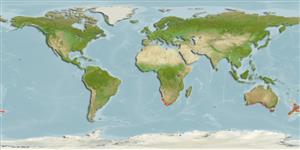>
Eupercaria/misc (Various families in series Eupercaria) >
Emmelichthyidae (Rovers)
Etymology: Plagiogeneion: Greek, plagios = oblique + Greek, geny, genyos, diminutive = face (Ref. 45335).
Environment: milieu / climate zone / depth range / distribution range
Ökologie
seewasser bathydemersal; tiefenbereich 30 - 600 m (Ref. 106682). Deep-water; 22°S - 40°S, 14°E - 170°E
Southeast Atlantic: Vema Seamount west of Cape Town and off Algoa Bay, and Walvis Bay in Namibia. Southern Indo-West Pacific: St. Paul and Amsterdam Islands, southern Australia, and New Zealand.
Size / Gewicht / Alter
Maturity: Lm ? range ? - ? cm
Max length : 60.0 cm TL Männchen/unbestimmt; (Ref. 5325); common length : 40.0 cm TL Männchen/unbestimmt; (Ref. 115123); max. veröff. Alter: 10 Jahre (Ref. 35378)
Rückenflossenstacheln (insgesamt) : 12; Rückenflossenweichstrahlen (insgesamt) : 10 - 12; Afterflossenstacheln: 3; Afterflossenweichstrahlen: 10. Rosy pink in color, brownish dorsally, silvery below; fins red, tips of caudal fin blackish (Ref. 5325).
Adults occur near sandy or muddy bottom in deep water. Feeds on larger zooplankton (Ref. 3394). Marketed fresh or frozen and proves to be an excellent foodfish (Ref. 115123).
Life cycle and mating behavior
Geschlechtsreife | Fortpflanzung | Ablaichen | Eier | Fecundity | Larven
Heemstra, P.C., 2016. Emmelichthyidae. pp. 2526-2533. In K.E. Carpenter and N. De Angelis (eds.). The living marine resources of the Eastern Central Atlantic. Vol. 4: Bony fishes part 2 (Perciformes to Tetradontiformes) and sea turtles. FAO Species Identification Guide for Fishery Purposes, Rome, FAO. pp. 2343-3124. (Ref. 115123)
IUCN Rote Liste Status (Ref. 130435: Version 2024-1)
Bedrohung für Menschen
Harmless
Nutzung durch Menschen
Fischereien: kommerziell
Tools
Zusatzinformationen
Download XML
Internet Quellen
Estimates based on models
Preferred temperature (Ref.
123201): 9 - 19.7, mean 14.2 °C (based on 63 cells).
Phylogenetic diversity index (Ref.
82804): PD
50 = 0.5313 [Uniqueness, from 0.5 = low to 2.0 = high].
Bayesian length-weight: a=0.01072 (0.00491 - 0.02339), b=3.07 (2.87 - 3.27), in cm total length, based on LWR estimates for this species & (Sub)family-body (Ref.
93245).
Trophic level (Ref.
69278): 3.4 ±0.45 se; based on food items.
Generation time: 3.7 ( na - na) years. Estimated as median ln(3)/K based on 1
growth studies.
Widerstandsfähigkeit (Ref.
120179): mittel, Verdopplung der Population dauert 1,4 - 4,4 Jahre. (tmax=10; K=0.33; tm=3-4).
Fishing Vulnerability (Ref.
59153): Moderate vulnerability (41 of 100).
Nutrients (Ref.
124155): Calcium = 24 [15, 56] mg/100g; Iron = 0.518 [0.212, 0.995] mg/100g; Protein = 17.8 [16.8, 18.7] %; Omega3 = 0.365 [0.214, 0.620] g/100g; Selenium = 18.2 [8.0, 38.5] μg/100g; VitaminA = 11.7 [2.7, 51.2] μg/100g; Zinc = 0.367 [0.255, 0.547] mg/100g (wet weight);
